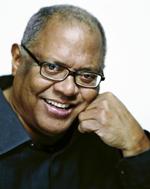Luciano “Chano” Pozo Gonzalez (Havana, January 7, 1915 – New York, December 2, 1948) was a renowned percussionist and composer, known as “El Tambor de Cuba.” He was a revolutionary jazz drummer, introducing in the American music genre “a new and vigorous energy”, according to outstanding Cuban ethnologist Don Fernando Ortiz.
Dizzy Gillespie has said about Chano that he was way ahead of his time: «The percussionists, the current drummers have remained true to his style. They have not really strayed from what Chano Pozo played yet. They do some different things, of course, but it was Chano Pozo who laid the foundations.”
In “Chano Pozo, la Vida” (1915-1948), Rosa Marquetti sought and achieved, as it is written in the back cover notes that accompany the volume, “…to follow the trail of the legend, trying to find actual clues that reaffirm it; to visualize, beyond the anecdote, the spontaneous genius of a controversial man if there was ever one; to document the circumstances that made his contribution to Cuban musical culture and jazz possible, and to provide access to the knowledge of relevant facts that, without his knowing or wanting them, made his life a brief, incontestable myth.”
The book is divided in six chapters that go through Chano’s brief but intense life. In the chapter titled “Early Years (1915-1946)”, the author goes through “those random and miserable beginnings of his path in life, which gave him an unkind welcome.” It also includes his first creations and recordings in Cuba and his appearances in cabarets and the movies.
As a matter of fact, the section “RHC Cadena Azul and Amado Trinidad (1941-1946)” actually recalls his beginning in this radio station, where “…He found the right place to give free rein to all his potentialities, genius and playing skills, because he was warmly welcomed by those who ruled the station.” It also addresses his working relations with another star of Cuban music, Rita Montaner.
“Nuebayol-Labana-Nuebayol (1946-1947)” is, perhaps, the most attractive chapter, for it gathers his first forays into the American city of New York; and his meetings with other Cuban musicians that had already settled there, such as Mario Bauza, Miguelito Valdes, Arsenio Rodriguez, Marcelino Guerra, Rapindey, Machito and his Afro-Cubans, Olga Guillot and many others.
The summit of Chano Pozo’s brief artistic career is exposed in “Ahora si! (1947)”. The reader will enjoy the great moments that he lived after he met famous trumpeter Dizzy Gillespie and joined Dizzy’s band. The author says, “Chano seduced Gillespie in the best sense and in the way that he knew best: exacting some devilish sounds from his inseparable drum with a performance all too brilliant to forget.”
This meeting between the two geniuses “necessarily marked a milestone in the hectic and original scene of Jazz in the USA.” Thereafter, the crisscross of Afro-Cuban elements with Jazz made in the United States was effectively completed and that is basically Chano’s contribution to what would later be defined as Latin Jazz or Afro-Cuban jazz.
The book also tells the story of the tragic events that led to Chano Pozo’s murder, by Puerto Rican Eusebio Muñoz, El Cabito, on a cold night in December 1948.
Don Fernando Ortiz also commented on Chano Pozo: “Chano’s grandparents spoke through Chano’s drum, but all of Cuba also spoke; because Chano, the musician, who grafted new and vigorous energy into American Jazz, was Cuban “one hundred percent.”
Actually, Fernando Ortiz’s words reveal the importance of preserving for the new and future generations of Cubans the work of musicians who, like Chano Pozo, contributed and still contribute to keep genuine Cuban art alive.
In the following video, Dizzy Gillespie explains the process of creating the song “Manteca” and how Chano Pozo suggested the entries of each instrument. Unfortunately, it is not translated, but it can be understood. In the second part of the video, you can relish the original recording, in 1948, of “Manteca.”
Translated by Pedro A. Fanego




